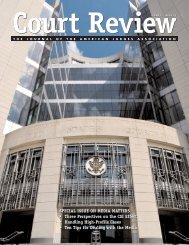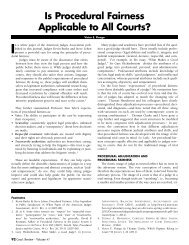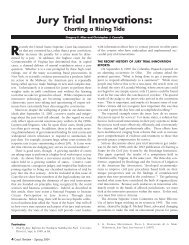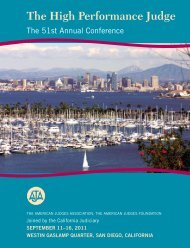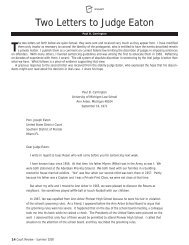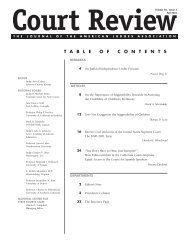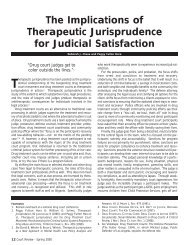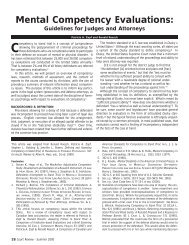Special Issue on Procedural Fairness - American Judges Association
Special Issue on Procedural Fairness - American Judges Association
Special Issue on Procedural Fairness - American Judges Association
- No tags were found...
Create successful ePaper yourself
Turn your PDF publications into a flip-book with our unique Google optimized e-Paper software.
additi<strong>on</strong>, <strong>Fairness</strong> Heuristic Theory 38 posits that fair treatmentis an indicati<strong>on</strong> that the authority is trustworthy and that complyingwith their directi<strong>on</strong> will not lead to exploitati<strong>on</strong>. Thesec<strong>on</strong>cerns about group status and exploitati<strong>on</strong> may be <strong>on</strong>es thatare not shared by authorities or decisi<strong>on</strong> makers, and above,we provide evidence that authorities are more focused <strong>on</strong>group protecti<strong>on</strong> than are decisi<strong>on</strong> recipients when evaluatingprocedures. 39In additi<strong>on</strong> to affecting the informati<strong>on</strong> that people aremotivated to seek out, decisi<strong>on</strong> making status may also changethe way that informati<strong>on</strong> about a scenario is processed. Smithand Trope c<strong>on</strong>ducted an experiment in which they primed participantsfor either high or low power, and found that thoseprimed for high power engaged in more abstract, less detailedprocessing of stimuli than did those primed for low power, anddid so even when this resulted in worse performance <strong>on</strong> atask. 40 Their findings indicate that high power leads people toview stimuli in a different way, focusing <strong>on</strong> gist and “big picture”trends rather than details, and categorizing eventsbroadly. If those with legal decisi<strong>on</strong> authority are more focused<strong>on</strong> group-level and societal-level c<strong>on</strong>cerns than are decisi<strong>on</strong>recipients, this may influence the way that they process informati<strong>on</strong>,as well as the informati<strong>on</strong> that they attend to, whenevaluating a legal procedure. In line with the findings of Leunget al, 41 this group-level focus may result in an emphasis <strong>on</strong> collectiveoutcome favorability when evaluating procedures.CONCLUSIONS AND IMPLICATIONSThus far, the research suggests that decisi<strong>on</strong> makers are lessaffected by procedural c<strong>on</strong>cerns than are decisi<strong>on</strong> recipients.In three of four studies c<strong>on</strong>ducted by Heuer et al, 42 there wasno effect of respectful or dignified treatment <strong>on</strong> the proceduralfairness judgments of the authorities – this effect was observed<strong>on</strong>ly am<strong>on</strong>g the subordinates. Recently, we have begun toinvestigate why this might be the case, and findings indicatethat decisi<strong>on</strong> makers’ fairness judgments are shaped by c<strong>on</strong>cernfor group protecti<strong>on</strong> to a greater extent than are those ofdecisi<strong>on</strong> recipients. However, there are a number of other factorsthat might lead to the discrepancy between decisi<strong>on</strong> makersand decisi<strong>on</strong> recipients, and further research is required toidentify the priorities that occupy the focus of decisi<strong>on</strong> makers,and lead them to emphasize instrumental c<strong>on</strong>cerns in theirfairness judgments, when decisi<strong>on</strong> recipients are clearlyfocused <strong>on</strong> treatment.An important point to note in this work is its dem<strong>on</strong>strati<strong>on</strong>that the applicability of procedural fairness research is morenuanced than has previously been acknowledged. While anumber of procedural fairness theorists have argued that themeaning of fairness changes across situati<strong>on</strong>s, 43 and othershave suggested that outcome c<strong>on</strong>cerns and relati<strong>on</strong>al c<strong>on</strong>cernscan be differentially important in different c<strong>on</strong>texts, 44 n<strong>on</strong>e ofthese perspectives have explored the c<strong>on</strong>trast between decisi<strong>on</strong>makers and decisi<strong>on</strong> recipients. The recogniti<strong>on</strong> that decisi<strong>on</strong>makers’ fairness judgments operate differently to those of decisi<strong>on</strong>recipients opens new avenues for inquiry in the proceduralfairness literature, and calls for better understanding ofthe psychological underpinnings of fairness reas<strong>on</strong>ing am<strong>on</strong>gdecisi<strong>on</strong> makers, including judges.Diane Sivasubramaniam was awarded a PhD inPsychology from the University of New SouthWales in Sydney, Australia in 2006, and is currentlya Postdoctoral Fellow at BarnardCollege, Columbia University. She is workingwith Professor Larry Heuer <strong>on</strong> a Nati<strong>on</strong>alScience Foundati<strong>on</strong> grant, investigating thetopic outlined in this paper: the disparity indecisi<strong>on</strong> makers’ and decisi<strong>on</strong> recipients’ justicereas<strong>on</strong>ing, the c<strong>on</strong>diti<strong>on</strong>s under which this disparity occurs, andthe reas<strong>on</strong>s for its existence. Her research also examines proceduraljustice reas<strong>on</strong>ing in restorative justice c<strong>on</strong>ference processes,which are rapidly emerging in legal systems worldwide. In Fall,2008, she will join the Faculty of Criminology, Justice and PolicyStudies at the University of Ontario Institute of Technology(UOIT). She can be reached at diane.sivasubramaniam@uoit.ca.Larry Heuer (PhD, University of Wisc<strong>on</strong>sin-Madis<strong>on</strong>) is a professor of psychology at BarnardCollege of Columbia University. His primaryresearch interests are the psychology of fairnessand jury decisi<strong>on</strong> making. Some of his work canbe found at www.columbia.edu/~lbh3. His emailaddress is LBH3@Columbia.edu.38. E. Allan Lind, <strong>Procedural</strong> Justice and Culture: Evidence forUbiquitous Process C<strong>on</strong>cerns., 15 ZEITSCHRIFT FUR RECHTSSOZIOLOGIE24 (1994).39. Sivasubramaniam et al., supra note 25.40. Pamela K. Smith & Yaacov Trope, You Focus <strong>on</strong> the Forest WhenYou’re in Charge of the Trees: Power Priming and AbstractInformati<strong>on</strong> Processing, 90 J. PERSONALITY & SOC. PSYCHOL. 578(2006).41. Leung et al., supra note 34.42. Heuer et al., supra note 13.43. E.g., Francis J. Flynn & Joel Brockner, It’s Different to Give Than toReceive: Predictors of Givers’ and Receivers’ Reacti<strong>on</strong>s to FavorExchange, 88 J. APPLIED PSYCHOL. 1034 (2003); Gerald S.Leventhal et al., Bey<strong>on</strong>d <strong>Fairness</strong>: A Theory of Allocati<strong>on</strong>Preferences, in JUSTICE AND SOCIAL INTERACTION 167 (Gerold Mikulaed., 1980); Robin I. Lissak & Blair H. Sheppard, Bey<strong>on</strong>d <strong>Fairness</strong>:The Criteri<strong>on</strong> Problem in Research <strong>on</strong> Dispute Interventi<strong>on</strong>, 13 J.APPLIED SOC. PSYCHOL. 45 (1983); Blair H. Sheppard et al.,<strong>Procedural</strong> Justice from the Third-Party Perspective, 54 J.PERSONALITY & SOC. PSYCHOL. 629 (1988); Tomas Ståhl et al., Onthe Psychology of <strong>Procedural</strong> Justice: Reacti<strong>on</strong>s to Procedures ofIngroup vs. Outgroup Authorities, 34 EUROPEAN J. SOC. PSYCHOL. 173(2004).44. E.g., Kees van den Bos et al., <strong>Procedural</strong> and Distributive Justice:What Is Fair Depends More <strong>on</strong> What Comes First Than <strong>on</strong> WhatComes Next, 72 J. PERSONALITY & SOC. PSYCHOL. 95 (1997); Skitka,supra note 10; Linda J. Skitka & David A. Houst<strong>on</strong>, When DueProcess Is of No C<strong>on</strong>sequence: Moral Mandates and PresumedDefendant Guilt or Innocence, 14 SOC. JUST. RES. 305 (2001)70 Court Review - Volume 44



